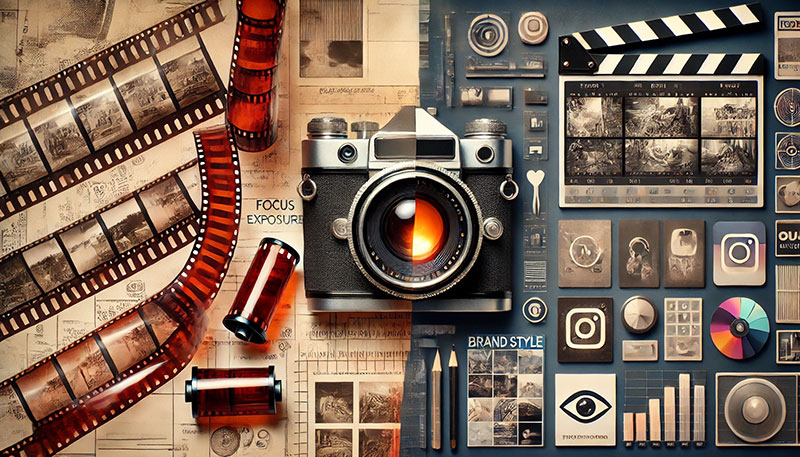By Duke Wells
In the age of instantaneous selfies and perfectly curated social media grids, it might seem counterintuitive to look backward for lessons in branding.
But analog photography — with its tactile process, chemical imperfections, and delayed gratification —offers profound insights for how brands can craft, maintain, and evolve their image in a hyper-digital world.
The Camera Doesn’t Lie — But the Photographer Frames the Truth
In analog photography, every frame counts. You don’t shoot 500 photos to get one “likeable” image. You compose, you measure light, you wait.
It’s an intentional act.
Branding is no different. In today’s crowded marketplace, quick reactivity often masquerades as authenticity. But consumers are savvy; they can tell when something’s posed versus when it’s purpose-driven. Just as an analog photographer must pre-visualize their shot, brands must pre-visualize their presence — crafting each message with clarity and care.
Lesson: Be intentional. Every interaction is a frame in your brand’s narrative. Don’t overshoot — overthink (in the best way).
Focus Isn’t Just Sharpness — It’s Priority
Analog cameras require manual focus. You turn a ring. You calibrate. If you miss, the moment blurs.
Modern brand management operates in a similarly delicate space.
With countless channels — from TikTok to trade shows — brands can lose focus quickly. But sharp branding depends on a deep understanding of what matters most. Is your message crisp? Is your purpose in focus? Or are you scattering attention across too many noisy platforms?
Lesson: Focus isn’t just clarity — it’s commitment. Know your brand’s focal point and stick to it.
Exposure = Balance
In film photography, overexposure washes out the image. Underexposure hides detail. Striking the right balance means honoring both light and shadow.
Today’s brands also must manage exposure — particularly in terms of visibility and vulnerability. Some brands fear overexposure (leading to PR missteps), while others struggle with underexposure (fading into obscurity). Effective brand management requires calibrated storytelling: enough light to reveal character, but enough restraint to maintain intrigue.
Lesson: Find your exposure value. Be visible but not oversaturated. Be authentic but not overexposed.
The Power of Grain and Imperfection
Digital perfection is sterile. Analog photography embraces texture: film grain, lens flares, color shifts. These imperfections are part of what make analog photos feel real.
Likewise, today’s consumers crave human brands. Perfection feels corporate. Vulnerability feels trustworthy. Your flaws — if owned with honesty — can become your differentiators. Think of Patagonia’s “Don’t Buy This Jacket” campaign, or Dove’s Real Beauty series. Both celebrated imperfection—and won loyalty.
Lesson: Embrace your grain. Flaws build authenticity. Texture is memorable.
The Darkroom is Where the Magic Happens
In analog photography, images aren’t instant. They develop in darkness. Chemicals react. Time passes. The result is an image that was carefully coaxed into existence, not hastily filtered.
Brands too need darkrooms: spaces away from the spotlight where ideas can evolve.
Rushing into trend-chasing or reactive marketing can stunt creative growth. The best campaigns are rarely born on a brainstorming whiteboard — they’re developed in silence, in struggle, in nuance.
Lesson: Give your brand room to develop. Maturation is part of the art.
You Don’t Always Need a Do-Over — You Need a Contact Sheet
Film photographers often print contact sheets — a set of thumbnail images showing every shot on the roll. It’s a tool for reflection: what worked, what didn’t, what might have been overlooked.
Brands, too, need contact sheets. Retrospective reviews, brand audits, customer feedback — these aren’t luxuries, they’re necessities. It’s in review that clarity emerges.
Lesson: Reflection improves execution. Don’t delete your past. Study it.
Shoot with Purpose. Develop with Patience. Expose with Care.
In a world obsessed with instant gratification and filtered perfection, analog photography reminds us of the beauty in being deliberate. Of seeing light and shadow not as opposites, but as partners. Of treating every shot, every message, as a piece of a bigger picture.
Your brand is a negative waiting to be developed.
The image you produce will depend not just on your tools, but on your timing, your technique, and your willingness to embrace imperfection.
So… are you ready to take the shot?
Duke Wells created BahamasB2B in 2000 following a successful career as an advertising photographer in Detroit and New York. Mr Wells was an executive board member of the Advertising Photographers of America and a photography instructor at the College for Creative Studies. He was the first photographer to have a major solo exhibition at the National Art Gallery of The Bahamas. In 2013, Mr Wells and his wife Lisa, a Bahamian artist, created The Bahamian Project — a non-profit photography initiative honouring the cultural legacy of The Bahamas and its people.



